SpaceX's private Polaris Dawn space crew talks about their ambitious mission (exclusive)
The first commercial spacewalk and a big charity push are built into the mission, which includes an Inspiration4 astronaut.
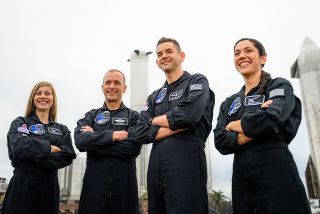
Polaris Dawn's astronauts have a big mission in front of them.
The four crew members of Polaris Dawn aim to once again raise money for St. Jude Children's Hospital in Memphis while performing the first commercial spacewalk, all after launching no earlier than December 2022.
The mission will host Inspiration4 astronaut and billionaire Jared Isaacman, who paid for all four seats on SpaceX's Crew Dragon for both that mission and the coming flight. (He and the other astronauts of Inspiration4 raised $250 million for St. Jude while in orbit last year.)
Isaacman will be commander of Polaris Dawn, flying with three people well-versed in aerospace operations: Anna Menon and Sarah Gillis, both lead operations engineers at SpaceX, and retired United States Air Force (USAF) pilot Scott "Kidd" Poteet.
In a written Q&A, crew members of Polaris Dawn shared stories of the astronaut mentors who inspired them to fly, what they want to do in orbit, and the charitable objectives that underlie the larger Polaris Program.
Related: SpaceX's private all-civilian Inspiration4 mission in pictures
Jared Isaacman, commander
Jared Isaacman led the SpaceX Inspiration4 mission in 2021 before announcing Polaris Dawn and the two future Polaris Program missions earlier this year. Isaacman is the billionaire founder and CEO of Shift4 payments and an accomplished pilot, with roughly 6,000 hours of flight experience. He owns a jet-pilot training company, Draken International, and has conducted a high-speed circumnavigation of the world, among other milestones.
Get the Space.com Newsletter
Breaking space news, the latest updates on rocket launches, skywatching events and more!
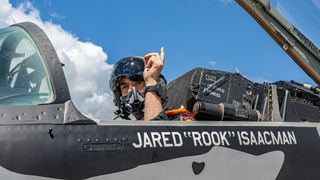
Space.com: What did you miss during Inspiration4 that you would like to do this time?
Isaacman: I will try my best to pause for a moment and enjoy the environment I am fortunate to be in, the view few others have seen. I was very focused on the mission and timeline with Inspiration4, and I know I will be again, but hopefully I can take in some of those special moments.
Space.com: How has being to space changed you, or your charitable approach?
Isaacman: Inspiration4 and now Polaris just became a bigger platform for doing the right thing. I have always tried to incorporate important charitable causes in my past adventures — always trying to ensure the mission served a bigger purpose. That obviously didn't change with Inspiration4 or Polaris. We could just accomplish things on a much bigger scale.
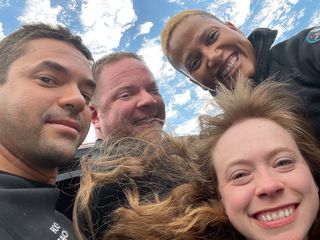
Space.com: What's training been like?
Isaacman: Similar to Inspiration4, time just disappears. The days and weeks just melt away but in this case, the training program is much longer and even more intense. The longer mission duration has allowed us to take five days' worth of specialized research, each of which comes with specialized training. This is in addition to the unique developmental aspects of the mission — like a new EVA [extra-vehicular activity, or spacewalk] spacesuit and a simulation campaign specific for EVA and high-radiation orbits.
Space.com: What is the most challenging or interesting part of training?
Isaacman: The EVA training is really interesting. It brings with it new levels of space medicine, a deeper understanding of the ECLSS [environmental control and life support systems] and their modifications for this mission. [We have] a number of exciting training environments like SCUBA, skydiving, altitude chamber, suspension systems and a simulation campaign that focuses on the nominal and contingency procedures we need to master. It is very exciting.
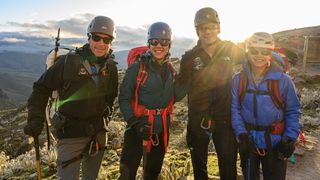
Space.com: What part of the mission are you most looking forward to?
Isaacman: My job is really to look at the entirety of the mission and all of our objectives. It's why with Inspiration4 the training, the team building, the mission, the research and the fundraising for St. Jude were all of equal importance. That is no different with the Polaris Program. We have a lot of ambitious objectives that I want to make sure we achieve. It is all so important.
Space.com: What special items will you be bringing with you for the mission?
Isaacman: Personally, I will bring some small items for my wife and daughters, but for the most part our mass allocation is being prioritized for science, research and the ECLSS modifications needed to meet our objectives.
Space.com: What outreach do you plan to perform?
Isaacman: We will continue the fundraising and awareness we began with St. Jude. We have raised over $250 million and the work is far from done. I would expect St. Jude to play a big role in all phases of our mission, before, during and after splashdown.
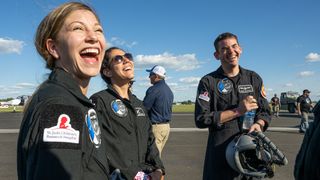
Space.com: How did you select this crew?
Isaacman: Polaris is very much a joint effort with SpaceX. We decide on a lot of things together with respect to the Polaris Program. In the case of the crew, we built a crew to meet the mission objectives. Of course, having familiarity and trust with everyone from Inspiration4 played a part, but I think if you look at each crew member's background, you can see why they are so well suited for this mission and the objectives we aim to accomplish.
Space.com: What are you hoping to accomplish in the future Polaris missions?
Isaacman: Each mission should build off the previous one and hopefully much can be learned from the science, the research and all the technology we aim to demonstrate. When Polaris is over, the first crewed Starship should have flown and that is the vehicle that will open space to the many. [Starship is the SpaceX human spacecraft being developed for deep-space missions; the final Polaris flight will rely on it.] It will return humans to the moon and ultimately to Mars and beyond. It is amazing to really even think about.

Sarah Gillis, mission specialist
Sarah Gillis is lead space operations engineer at SpaceX. She was responsible for astronaut training for missions including Inspiration4 and NASA's Demo-2 crewed test flight and Crew-1. Her mission control operations experience includes navigation officer for Dragon cargo resupply missions and crew communication for Dragon human spaceflight missions.
Gillis originally planned to be a classical violinist, but high school mentor and NASA astronaut Joe Tanner helped her decide to sign up for aerospace engineering. Gillis joined SpaceX in 2015.
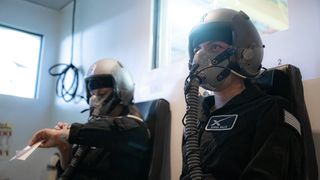
Space.com: How long have you been wanting to go to space?
Sarah Gillis: I don't think I had really considered the possibility of going to space before my junior year of high school, when I met an astronaut for the first time. It always seemed like something far outside the realm of possibility, though, so it wasn't something I focused a lot of energy toward over the years. Instead I tried to pursue and learn things that I found interesting, and somewhere along the way I ended up building a skill set that is highly applicable to human spaceflight.
Space.com: What's training been like?
Sarah Gillis: It's been incredibly fun to be on this side of training, getting to focus on team cohesion and learning the new mission-specific objectives. I find it really inspiring and motivating to learn alongside this crew. Everyone brings their expertise to the table. It's quite a collaborative environment. We all get along really well, which makes for a lot of laughter during training ... in between all of the learning, of course!
Space.com: What is the most challenging or interesting part of training?
Gillis: I think the most interesting thing I've observed so far is that even though we individually bring a lot of Dragon knowledge to the table, we still have plenty to learn when it comes to working efficiently and effectively as a team. It's really fun to engage in the process of refining our crew resource management as we continue gelling as a team.
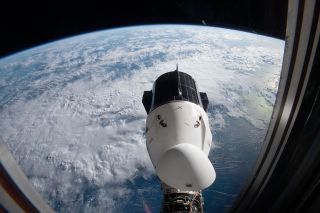
Space.com: How does the Polaris Dawn crew training compare with the NASA astronauts who fly aboard Crew Dragon?
Gillis: Our Dragon training program is identical to the NASA astronaut training program, aside from topics that relate to rendezvous and docking with the International Space Station, based on our free-flyer trajectory. In addition, we have added an entire training program to prepare us to use the new EVA suit and execute the EVA operation, as well as mission-specific training for the 40 or so research experiments we will be performing in-flight. Finally, the SpaceX medical team has done an awesome job creating a new medical training program that is similar to what NASA crew members undergo.
Space.com: What skillset does mission operations really teach you for spaceflight?
Gillis: There are a lots of skills that directly apply both in mission control as well as in spaceflight. Because space is an unforgiving environment, you have to learn how to work as part of a very high-functioning team to avoid mistakes. You learn how to communicate effectively and concisely, to ensure the correct decisions can be made quickly and safely. You learn how to execute checklists and follow procedures, which combined with a deep understanding of the spacecraft systems allows you to quickly problem solve and troubleshoot any issues arise.
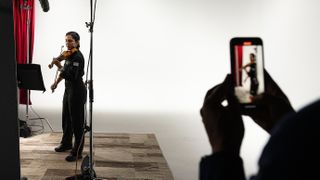
Space.com: What part of the mission are you most looking forward to?
Gillis: I'm really just trying to enjoy every part of this whole experience, from the training through to a safe splashdown at the end of the mission. While on-orbit, I think I am most looking forward to living and working in the microgravity environment.
What special items will you be bringing with you for the mission?
Gillis: I have some work to do to figure out what I will be flying on the mission, but I'm open to suggestions!
Space.com: What outreach do you plan to perform? Are you planning to perform music on orbit?
Gillis: I would love the opportunity to perform music on orbit! We are still working the plan for all of the in-flight activities, but I definitely hope it makes the list.

Anna Menon, mission specialist and medical officer
Anna Menon is lead space operations engineer at SpaceX, and has worked as a mission director and crew communicator along with managing crew operations development. Notable missions she has worked on include include Demo-2, Crew-1 and uncrewed cargo missions CRS-22 and CRS-23.
Prior to joining SpaceX, Menon worked at NASA as a biomedical flight controller for the International Space Station, including serving as lead for Expedition 47/48's biomedical operations. Her fourth grade teacher, Alison Smith Balch, inspired Menon's passion in space. Smith Balch was daughter of NASA astronaut and pilot Michael J. Smith, who died during the Challenger shuttle accident of 1986.
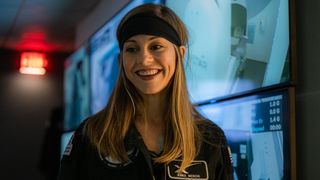
Space.com: How long have you wanted to go to space?
Anna Menon: I've dreamed of what it would look like to view our beautiful Earth from amongst the stars since I was a little girl. I first was inspired to work in this field at 9 years old on a field trip to NASA's Johnson Space Center. There, I experienced a day in the life of both a flight controller in Mission Control and an astronaut. From that point forward, it became my dream to contribute to this industry with my career.
Space.com: What research are you looking forward to performing?
Menon: There are so many research experiments I'm excited about on this mission! We have selected approximately 40 different studies to undergo in five days, and each of them will explore novel and important ideas to help us improve life both here on Earth and on future missions deeper into space. A couple experiments that come to mind for which I'm excited will involve doppler ultrasound of the kidneys and liver to better understand pharmacokinetics, and endoscopy of our airways to better understand administration of lifesaving intubation strategies for space missions.
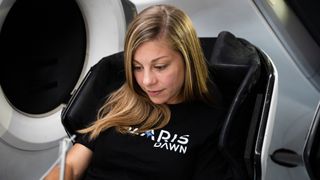
Space.com: How does a career of developing critical operational responses for spacecraft emergencies for others prepare you for operating a spacecraft?
Menon: One aspect is that it has afforded me a history and technical background on not just the what, but the whys, of our operations. This background can inform our decisions and actions in flight to help our crew accomplish our mission objectives. Additionally, I carry with me years of working as a teammate to the many brilliant SpaceX engineers in Mission Control; this experience can hopefully help serve as a bridge between our crew in space and the fantastic team on earth supporting us.
Space.com: What are you looking forward to telling your kids and family when you return?
Menon: Well first, I plan to give them the most giant hug and tell them for the millionth time how much I love them. But then after that, I am excited to share stories with them. I hope I can bring this experience to life for them in a way that will touch their lives as much as I am positive it will touch mine. My dream is that one day, space is as — or even more — accessible to people as airplanes and cars are today. Until that day, I will try to paint a picture for my kids and family of the beauty of our planet and the vastness of the stars and universe that surround us, from the vantage point of flying amongst them.
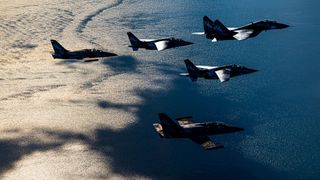
Scott Poteet, pilot
Scott "Kidd" Poteet is a retired United States Air Force (USAF) Lieutenant Colonel. He has 3,200 flying hours in aircraft including the F-16, A-4, T-38, T-37, T-3 and Alpha Jet. He has more than 400 hours of combat experience as well.
Poteet served 20 years in the Air Force, including senior roles like 64th Aggressor Squadron, USAF Thunderbird No. 4 demonstration pilot, operational test and evaluation pilot and flight examiner. Afterwards, he served as director of business development at Draken and president of strategy at Shift4, both companies of Isaacman's. Poteet was also Inspiration4's mission director.
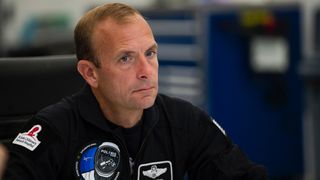
Space.com: How long have you wanted to go to space?
Scott Poteet: I always assumed space was very unlikely due to my academic performance in grade school and college despite being a huge fan of the movie "The Right Stuff" back in the 1980s. Once this became a reality last year, I've embraced the opportunity and remain committed to sharing as much of the journey as I can with the public. It's just another example of how space exploration will be more accessible to future generations.
Space.com: How will you be using your military experience in orbit?
Poteet: One thing I've noticed is the consistency between operations in the military and preparing for space. How we address training techniques and procedures is very similar to what I experienced in the Air Force. We are highly committed to understanding crew dynamics and honing checklist procedure discipline. I have immense confidence in the SpaceX team.
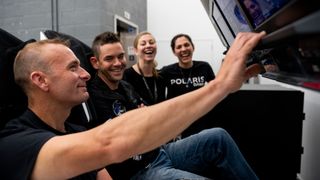
Space.com: How does the crew training compare with your basic military training?
Poteet: The attention to detail I've witnessed from the SpaceX team is beyond comparison with regard to how checklist procedures are executed, which is a true team effort to include mission control. There is a reason why SpaceX is leading the way in space exploration, and these men and women deserve their place in the history books. I'm excited to see what the future holds for all of us to experience.
Space.com: What do you think will be the legacy of Polaris Dawn?
Poteet: We just want to play a small role in the evolution of space exploration. We know this is a team effort with a very deep history of accomplishments from NASA. We certainly wouldn't be here without the sacrifices made by those who come before us. If we can make a small contribution to the greater good in space and here on earth, we'll have happy to proclaim "mission accomplished."
Space.com: What's training been like?
Poteet: To fully understand the extent of our training, I like to break it down into three distinct phases that are concurrent.
- Phase 1 is understanding the basics to include Falcon 9 and Dragon systems, avionics, procedures, contingency operations, etc.
- Phase 2 is focused on the specialized elements of our mission. This includes the EVA, the higher altitude, Starlink communication and the extensive science and research experiments.
- Last, in Phase 3 we address group dynamics, team building and getting "comfortable in uncomfortable situations." This type of training includes fighter jet training, mountain climbing, scuba diving, skydiving and water survival, to name a few. All in all, this is some of the best and most intense training I've experienced.
Space.com: What part of the mission are you most looking forward to?
Poteet: I think since there are so many milestones, objectives and tasks throughout the entire mission, it's hard to pinpoint one aspect. Just like one experiences on any type of military deployment, you get into an operational mindset with intense focus. We will be fully prepared for our mission, so striking the right balance between enjoying the experience and accomplishing our objectives is critical. Enjoying the view from our planned apogee will certainly be a highlight.

Space.com: What special items will you be bringing with you for the mission?
Poteet: Honestly, I haven't given it much thought. I'd consider myself a bit of a minimalist, so I'm not too committed to bringing much up there. I definitely want to bring something for each of my family members, but it cannot be too big since we're dedicating a majority of our cargo space to science and research and the additional items required for the EVA.
Space.com: What outreach do you plan to perform?
Poteet: Outreach is very important to our overall mission and St. Jude has been such a great partner throughout Inspiration4 and Polaris Dawn. We are always looking for new ways to support their cause to include several initiatives we are keeping close hold on until on orbit.
Space.com: What is the most challenging or interesting part of training?
Poteet: The most challenging aspect of training is keeping up with my amazing crew. With a seasoned astronaut and two experienced SpaceX engineers, I'm committed to not letting them down and want to make sure I contribute every way possible. All the hands-on training with climbing, diving and flying is the fun stuff.
Editor's note: This story was updated at 2:46 p.m. EDT with new information about the number of research experiments Polaris Dawn will carry.
Follow Elizabeth Howell on Twitter @howellspace. Follow us on Twitter @Spacedotcom and on Facebook.
Join our Space Forums to keep talking space on the latest missions, night sky and more! And if you have a news tip, correction or comment, let us know at: community@space.com.

Elizabeth Howell (she/her), Ph.D., is a staff writer in the spaceflight channel since 2022 covering diversity, education and gaming as well. She was contributing writer for Space.com for 10 years before joining full-time. Elizabeth's reporting includes multiple exclusives with the White House and Office of the Vice-President of the United States, an exclusive conversation with aspiring space tourist (and NSYNC bassist) Lance Bass, speaking several times with the International Space Station, witnessing five human spaceflight launches on two continents, flying parabolic, working inside a spacesuit, and participating in a simulated Mars mission. Her latest book, "Why Am I Taller?", is co-written with astronaut Dave Williams. Elizabeth holds a Ph.D. and M.Sc. in Space Studies from the University of North Dakota, a Bachelor of Journalism from Canada's Carleton University and a Bachelor of History from Canada's Athabasca University. Elizabeth is also a post-secondary instructor in communications and science at several institutions since 2015; her experience includes developing and teaching an astronomy course at Canada's Algonquin College (with Indigenous content as well) to more than 1,000 students since 2020. Elizabeth first got interested in space after watching the movie Apollo 13 in 1996, and still wants to be an astronaut someday. Mastodon: https://qoto.org/@howellspace
